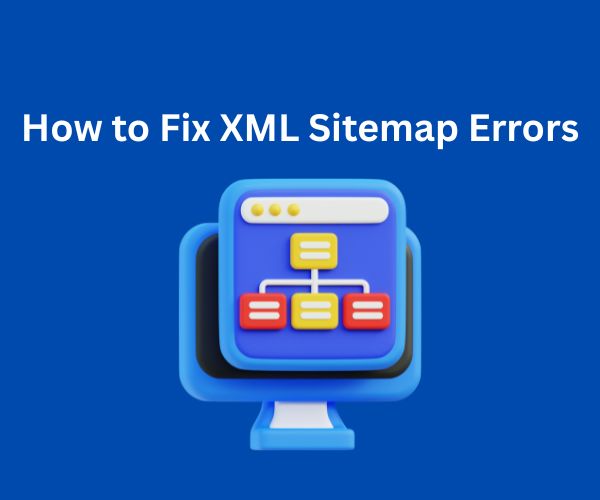Your XML sitemap is like a roadmap that tells Google which pages on your website are most important and should be indexed. But what happens when that roadmap is full of errors? Sitemap issues in Google Search Console (GSC) can prevent your pages from getting indexed and ranked properly.
In this guide, you’ll learn:
- What XML sitemaps do
- Why Google flags errors in them
- The most common types of sitemap errors
- How to fix each one step-by-step
What Is an XML Sitemap?
An XML sitemap is a file that lists all the important URLs on your website and helps search engines crawl and index them more effectively. It may also include metadata like when a page was last updated and how frequently it changes.
Example Sitemap URL:
Submitting it to Google Search Console ensures that your most important pages are visible to Google’s bots.
Why Google Flags Sitemap Errors
When Google reads your sitemap, it expects a clean list of URLs that are accessible, indexable, and properly formatted. If your sitemap includes broken links, redirect chains, disallowed URLs, or incorrect syntax, it can trigger errors in GSC.
Common XML Sitemap Errors (and How to Fix Them)
1. Submitted URL Not Found (404)
What It Means:
A URL listed in your sitemap returns a 404 error – the page doesn’t exist.
Fix:
- Remove the broken URL from the sitemap.
- If it was deleted by mistake, restore the page or redirect it using a 301 redirect.
- Re-submit your sitemap in GSC.
2. Submitted URL Soft 404
What It Means:
The page loads, but it has little or no content – or it behaves like a 404 without returning one.
Fix:
- Improve the page with valuable content.
- Or remove it from the sitemap if it’s not meant to be indexed.
3. Submitted URL Has Crawl Issue
What It Means:
Google couldn’t access the page, possibly due to server errors or timeouts.
Fix:
- Use tools like Google’s URL Inspection Tool or Screaming Frog to test the URL.
- Check your server logs and fix any connectivity or timeout problems.
4. Blocked by Robots.txt
What It Means:
The sitemap includes URLs that are blocked by the robots.txt file.
Fix:
- Edit your robots.txt file to allow crawling of important pages.
- Or remove blocked URLs from the sitemap if they shouldn’t be indexed.
Example:
User-agent: *
Disallow: /private-page/
5. Submitted URL Marked ‘Noindex’
What It Means:
The page is in your sitemap but has a noindex tag, telling Google not to index it.
Fix:
- Decide: Do you want this page indexed?
- Yes? Remove the noindex tag.
- No? Remove it from the sitemap.
- Yes? Remove the noindex tag.
6. Redirect Error
What It Means:
A sitemap URL redirects too many times or leads to a broken redirect chain.
Fix:
- Use a redirect checker tool to test the URL.
- Ensure only one redirect (ideally a 301) points directly to the final destination.
7. Incorrect Format or Syntax Errors
What It Means:
The sitemap file is not properly structured or has invalid entries.
Fix:
- Use the XML Sitemap Validator or Google’s sitemap testing tool.
- Make sure the file starts with the correct XML declaration and tags.
Example XML Structure:
xml
CopyEdit
<?xml version=”1.0″ encoding=”UTF-8″?>
<urlset xmlns=”http://www.sitemaps.org/schemas/sitemap/0.9″>
<url>
<loc>https://example.com/page1</loc>
<lastmod>2024-10-10</lastmod>
<changefreq>monthly</changefreq>
<priority>0.8</priority>
</url>
</urlset>
How to Fix Sitemap Issues in Google Search Console
Step-by-Step Guide:
- Go to Google Search Console
Navigate to the Indexing > Sitemaps section. - Check for Errors
Review the “Status” of your sitemap. Click to view specific error types. - Inspect the Problematic URLs
Use the URL Inspection Tool to test individual URLs for crawlability, index status, and live testing. - Fix the Root Cause
Based on the error (e.g., 404, redirect, noindex), apply the appropriate solution. - Update the Sitemap
Remove incorrect URLs or update them in your CMS or sitemap plugin. - Re-submit the Sitemap
Click “Resubmit” in GSC after making changes. - Monitor the Coverage Report
Track progress and make sure issues are resolved. It may take a few days to reflect.
Bonus Tips
- Automate sitemap generation using plugins like Yoast SEO, Rank Math, or Google XML Sitemaps if you’re on WordPress.
- Keep your sitemap under 50,000 URLs or 50MB. If it’s larger, split it into multiple sitemap files and use a sitemap index file.
- Update regularly, especially when adding or removing major sections of your site.
📌 FAQs
Q1. How long does it take for Google to re-crawl a corrected sitemap?
A: Typically within a few days, but it can vary based on your crawl budget and site authority.
Q2. Should I include non-canonical for paginated URLs in the sitemap?
A: No, only include the canonical (preferred) version of each page.
Q3. Can a sitemap error hurt my SEO rankings?
A: Yes. If Google can’t crawl or index important pages due to sitemap issues, it may limit your visibility in search results.
Q4. Is it okay to have URLs that return 301 in my sitemap?
A: Ideally, no. Sitemaps should contain live, indexable URLs – not redirects.
Conclusion
Fixing XML sitemap errors in Google Search Console is essential for healthy SEO. An accurate sitemap helps Google find and index your site’s best content. Make regular sitemap checks part of your SEO maintenance routine.
Learn Here Google Search Console vs Google Analytics: What’s the Difference


